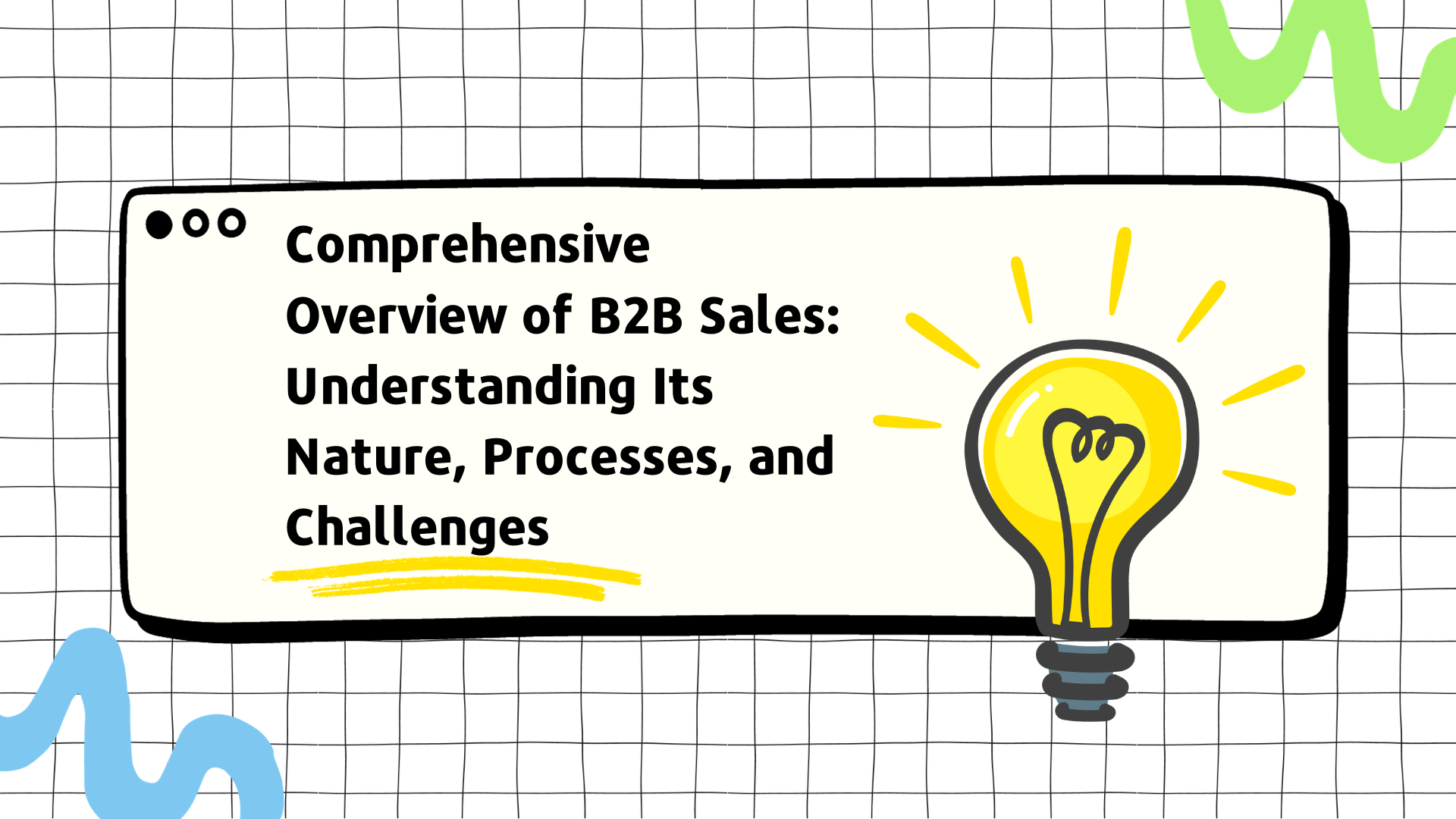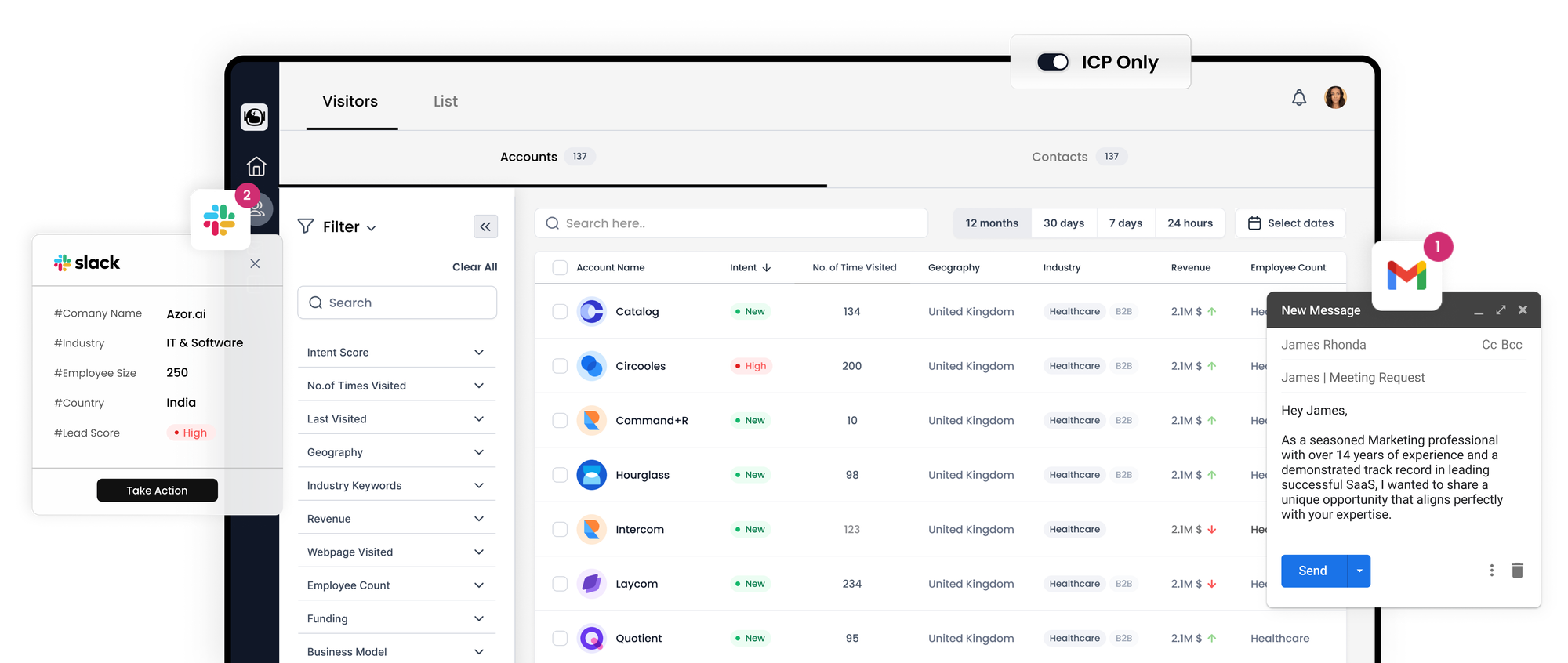Comprehensive Overview of B2B Sales: Understanding Its Nature, Processes, and Challenges

B2B (Business-to-Business) sales is a significant sales category where transactions occur between two businesses, contrasting the B2C (Business-to-Consumer) model where businesses sell directly to individual consumers. This guide explores the intricacies of B2B sales, highlighting key differences from B2C sales, challenges faced in B2B processes, and the role of B2B sales representatives.
Defining B2B Sales
- Nature of B2B Sales
Involves selling products or services from one business to another. The B2B sales process tends to be complex, lengthy, and involves high-value transactions.
- Collaborative Approach
Successful B2B sales require collaboration within and outside the organization, involving multiple stakeholders at various levels.

B2B vs. B2C Sales: Core Differences
1. Decision-Making Process
- B2B sales typically involve multiple decision-makers with varying needs and concerns, requiring sales reps to address and satisfy each stakeholder.
- In contrast, B2C sales usually involve a single decision-maker, simplifying the purchase process.
2. Nature of Products and Pricing
- B2B solutions are often feature-rich, tailored to address specific business challenges, and carry a higher price point.
- B2C products, catering to everyday consumer needs, usually fall into a lower price range.
3. Sales Relationship and Transaction Model
- B2B sales focus on building long-term relationships, often involving subscription-based models, especially in SaaS and software sales.
- B2C sales are generally one-time transactions.
4. Payment Process Complexity
- B2B payment processes are more complex, often involving trial periods and tailored payment plans based on feature usage.
- B2C transactions are straightforward, with direct payments from consumer to seller.
Challenges in B2B Sales
1. Managing an Unstructured Sales Process
- The diverse needs of multiple stakeholders can lead to a chaotic and unstructured sales process in B2B settings.
- Structuring the sales process involves detailed research, needs assessment, solution presentation, and identification of repeat business opportunities.
2. Data Overload
- Sales reps often face the challenge of sifting through extensive datasets to find relevant information.
- Proper tools and training are required to manage and utilize these datasets effectively.
3. Lengthy Sales Cycles
- The B2B sales cycle, averaging 102 days, involves numerous stages and touchpoints.
- Focusing on nurturing long-term relationships can expedite the sales process and move prospects down the sales funnel more efficiently.
Role of a B2B Sales Representative
- A B2B sales representative is tasked with employing specialized strategies to engage and influence business decision-makers.
- Their responsibilities include initiating sales calls, crafting tailored sales emails and pitches, arranging product demos, lead generation and nurturing, understanding customer pain points, and effectively handling rejections.
- They must possess extensive knowledge about their customer profiles, industry trends, and competitive landscape to influence the prospects’ decisions.
Strategic Insights
In conclusion, B2B sales demand a strategic approach, nuanced understanding of customer needs, and the ability to navigate through a multi-layered decision-making process. Sales representatives in this domain need to be adept at managing complex sales cycles, leveraging data effectively, and building strong, lasting relationships with clients. By understanding these dynamics, businesses can optimize their B2B sales strategies, leading to successful transactions and sustained growth.
Comprehensive B2B Sales Process: Essential Steps and Best Practices
B2B sales, or business-to-business sales, is a sophisticated and strategic process involving the sale of products or services from one business to another. Unlike B2C (Business-to-Consumer) sales, B2B transactions are characterized by longer sales cycles, higher value, and the involvement of multiple stakeholders. Understanding and effectively executing the B2B sales process is crucial for success in this arena. This guide elaborates on the key stages of the B2B sales process and provides insights into optimizing each step.
The Seven-Step B2B Sales Process
1. Research
- Foundation of Effective Sales: In-depth research is crucial before initiating sales interactions. Sales representatives should understand their products/services, target industries, competitors, and market trends.
- Ideal Customer Profiling: It involves identifying the buyer persona, understanding their challenges, and determining how your solutions can address these issues.
2. Prospecting
- Engaging High-Intent Prospects: It's vital to engage prospects who show interest in your offerings.
- Tools can aid in identifying high-intent prospects through real-time sales intelligence, enhancing the efficiency and effectiveness of prospecting efforts.
3. Need Assessment
- Aligning Customer Needs with Solutions: This stage involves confirming that potential customers’ needs align with what you offer.
- Sales reps should engage customers in open-ended conversations to understand their needs, challenges, and expectations.
4. Sales Pitch
- Crafting a Compelling Pitch: Develop a sales pitch that resonates with the prospects’ needs and effectively communicates the value of your products or services.
- Leverage tools’s Voice of Customer Analytics to tailor your pitch according to the prospect's requirements.
5. Handling Objections
- Managing Concerns and Questions: Objections are common in sales conversations. Sales reps should be prepared to address these empathetically and effectively.
- Real-time assistance tools can provide guidance on the best responses to objections, ensuring prospects feel heard and understood.
6. Conversion
- Closing the Deal: The conversion stage is crucial, where the sales team and the prospect agree on the terms and finalize the deal.
- This step includes sending proposals, negotiating prices, and mutually agreeing on terms.
7. Follow-up
- Building Long-term Relationships: Successful conversion opens opportunities for add-on features, upselling, and cross-selling.
- Regular follow-ups are essential to understand ongoing customer needs and offer relevant solutions, transforming one-time buyers into repeat customers.
Challenges and Solutions in B2B Sales
Adapting to Complex Sales Cycles
The B2B sales process can be intricate, with different needs and concerns at each step. Sales reps need to be adaptable and skilled in navigating these complexities.
Data Overload Management
Sales reps often face the challenge of handling vast amounts of data. Proper training and tools are necessary to use this data effectively.
Preparation for Sales Rejections
Rejections or objections are part of the sales process. Reps should be equipped with strategies and emotional intelligence to handle these situations productively.
Key Takeaways for B2B Sales Success
- The B2B sales process is a multi-step journey that requires careful planning, deep customer understanding, and strategic execution.
- Each stage, from research to follow-up, plays a vital role in moving prospects through the sales funnel and converting them into satisfied customers.
- Leveraging modern tools and technologies can significantly enhance the efficiency and effectiveness of the B2B sales process.
- Collaboration between sales and marketing teams is essential to ensure a seamless and successful sales cycle.
In conclusion, mastering the B2B sales process is integral to achieving sustained success in business-to-business markets. By understanding and optimizing each stage of the process, sales teams can better meet the needs of their customers, close more deals, and drive growth for their organizations.
Understanding the B2B Sales Funnel: Key Stages and Strategies for Success
The B2B sales funnel is a pivotal concept in understanding the journey of a customer in a business-to-business environment. Unlike the more sales rep-oriented sales process, the B2B sales funnel is customer-centric, focusing on guiding potential clients through various stages of engagement with your company and its offerings. This guide elaborates on the stages of the B2B sales funnel and outlines strategies to make B2B sales more effective.
Exploring the Stages of the B2B Sales Funnel
1. Awareness Stage
- The initial stage of the funnel aims to introduce prospects to your company and its products or services.
- The goal is to create brand awareness and pique the interest of target companies.
2. Interest Stage
- Here, the focus is on nurturing the prospect's interest.
- Prospects may begin their market research and start inquiring about pricing, timelines, and deliverables.
3. Desire Stage
- At this stage, prospects are generally impressed by what you offer and consider purchasing from you.
- They actively connect with your brand, indicating a strong interest.
4. Intent Stage
- Prospects in the intent stage are ready to buy but need clarification on which specific product or service best fits their needs.
5. Evaluation Stage
- A crucial point in the funnel, where prospects conduct an in-depth evaluation of your offerings.
- This stage determines whether your product or service is the right fit for them.
6. Action Stage
- The final decision-making stage where prospects decide to make a purchase.
- Successful navigation through this stage results in converting prospects into customers.
Strategies for Successful B2B Sales
Developing a Flexible Sales Strategy
Craft a strategy that accommodates various factors such as buyer-seller competency, product-intent fit, pricing, etc.
Choosing the Right Sales Technique
Select a B2B sales technique that aligns with both your sales team's capabilities and client preferences.
Implementing Sales Enablement Tools
Utilize tools to develop structured sales playbooks for guidance through the sales process.
Monitoring Sales KPIs
Regularly track key performance indicators (KPIs) to gauge growth and identify areas for improvement in sales performance.
Conclusion and Implementation
In summary, the B2B sales funnel is a comprehensive model that maps out the customer’s journey from initial awareness to the final purchase decision. Understanding and effectively managing this funnel is essential for successful B2B sales. By implementing strategic planning, selecting suitable sales techniques, and utilizing enabling tools, businesses can significantly enhance their sales processes. Regular monitoring and adjustment of strategies based on KPIs are also crucial for sustained success in B2B sales. Ultimately, a well-executed B2B sales funnel leads to more effective customer engagement, higher conversion rates, and improved business outcomes.
